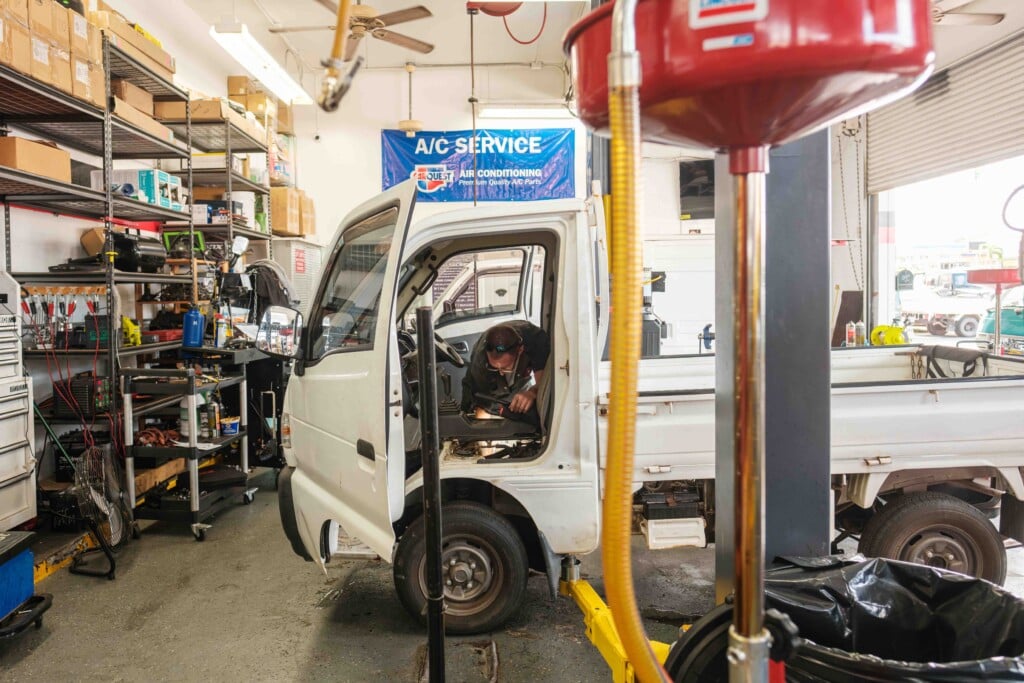Hawaiʻi Island Business Report 2021
The road to economic recovery is challenging, but businesses are optimistic as they take steps to reopen safely, and progress is made toward sustainable goals.

Downtown Hilo | Photo: Aaron Yoshino
Glimmer of Hope
The continued distribution of COVID-19 vaccines has brought a collective sigh of relief as businesses look ahead toward a post-pandemic future.
Hawaiʻi Island is known for its resiliency, and the past few years have shown its strength is unwavering. The community has bounced back from hurricanes, people came together to help each other during the 2018 eruption, which the island is still recovering from, and then the pandemic brought a year of uncertainties. Vaccinations, however, have provided hope for a return to normalcy as businesses continue taking preventive measures while gradually reopening the economy.
“I think an important lesson we have all learned this past year has been to expect the unexpected,” says George Pasha, IV, president and CEO of Pasha Hawai‘i.
“When the first COVID case was announced in the U.S. and later Hawai‘i in early 2020, I don’t think many of us thought we’d still be experiencing and battling the devastation and disruption this deadly pandemic has caused,” Pasha says. “There is hope on the rise as Hawai‘ i continues to vaccinate its residents and our economy opens up; however, it’s important for companies to have a business model in place that allows you to pivot quickly should circumstances change.”
In the fourth quarter of 2020, Hawai‘i County lost 10,300 or 14.4 percent of non-agricultural wage and salary jobs over the same quarter of 2019,” writes the Hawai‘i State Department of Business, Economic Development and Tourism (DBEDT) in its 1st Quarter 2021 report.
Hawai‘i County jobs decreased the most in accommodation (-3,600 jobs), followed by food services and drinking places (-1,100 jobs); transportation, warehousing, and utilities (-900 jobs); professional and business services (-900 jobs); and retail trade (-800 jobs). “The government sector lost 1,100 jobs or 7.1 percent in the quarter,” the report adds.

The new offices of W.H. Shipman, Limited, which will be completed this summer, are a renovation of a plantation-era residential building. | Photo: courtesy of W.H. Shipman
“We have been in a period of almost constant change for the last year, and that’s going to be with us for a while,” says Margaret Farias, president of W.H. Shipman, Limited. “Even as we return to normalcy, no one is quite sure what ‘normal’ is going to look like, and flexibility is going to be key. How much adjustment needs to be made varies greatly between individual businesses. For W.H. Shipman, Limited, we’ve really tried to focus our COVID response on safety and compassion, and we’ll be carrying that into the next year with us.”
DBEDT’s March 2021 state report provides a positive outlook for the future, projecting “Hawai‘i’s economy will experience improvement in 2021, with a projected 2.7 percent increase in real gross domestic product.”
However, DBEDT still forecasts it may take a few years to get back to pre-pandemic levels.
As vaccination distribution increases, tourism is on the rise. It has already made a 20% recovery in January and a 30% recovery in February, according to DBEDT.

Wendy J. Laros, President & CEO, Kona-Kohala Chamber of Commerce
“Tourism drives the economy on the west side of Hawai‘ i Island,” says Wendy Laros, president and CEO of Kona-Kohala Chamber of Commerce. “This includes air travel, ground transportation, lodging, retail, restaurants, tours and activities. The industry also partners with suppliers and service providers such as local farmers, fishermen, entertainers, florists or wedding planners,” she says. Laros is also a member of the State of Hawai‘i House Select Committee on COVID-19 Economic and Financial Preparedness.
“Opening up travel with the Safe Travels Hawai‘i program has been key for our island’s economic recovery. Businesses need customers to survive and now our customers are back. Occupancy is back up, and visitors are out and about shopping, taking tours and filling our restaurants,” Laros says. “The best path forward is to keep up the good work, continue adhering to safety guidelines as well as government mandates and enjoy being back in business.”
East Hawai‘i does not rely on tourism as heavily, but the resurgence of the visitor industry will help affected businesses.

Miles Yoshioka, Executive Officer, Hawaiʻi Island Chamber of Commerce
“Our members are doing OK, but many of them, like restaurants, tour groups and museums have been affected. I know some of our museums have taken the time and found the funding to do some improvements in preparation for that day (when tourism returns),” says Miles Yoshioka, executive officer of Hawai‘i Island Chamber of Commerce.
“Having one or two cruise ships a week would definitely add to our economy. Downtown Hilo is really quiet, many of the small shops have relied on the visitor industry, but thanks to a push by our organization, as well as many others, to support local and buy local, things are ringing true,” Yoshioka says. “I’ve heard people say they pulled away from Amazon and although they know it’s going to cost more, they’ll buy local if they can buy stuff here. It’s that kind of attitude that’s really carrying everyone through.”
The importance of supporting one another and learning how to adapt to changing circumstances are some of the lessons learned from the past year. There is also a hope that what has been learned can be improved upon and strengthened, and that the new creative business models developed over the past year will continue in future strategies.
“There’s really three takeaways that would position ourselves post-pandemic,” says Rachel Solemsaas, chancellor of Hawai‘i Community College. First would be to expand technology and distance learning opportunities. This allows Hawai‘i Island students to participate in university programs on other Islands without the need to relocate.
“We need to seize that opportunity,” says Solemsaas. “We need to advocate and ask that other institutions, the UH Board of Regents and the UH officers continue to invest in the distance education modality, make it more robust and expand more programs to really participate in distance education.”

Hawai‘i Community College agriculture students harvest crops to give to culinary arts students for food preparation the next day. | Photo: courtesy of Hawaiʻi Community College
The second takeaway is to create on-the-ground support for those distance education students and, third, would be to double down on digital equity gaps while broadening digital literacy.
“There’s a collective movement about addressing the infrastructure,” says Solemsaas. “We have to have more Wi-Fi, particularly in our rural communities, and we have to ensure that they have appropriate devices.”
At the Kona-Kohala Chamber of Commerce, Laros has been actively advocating businesses and topics, such as broadband infrastructure. New this year has been the ability to submit remote testimony via Zoom to the Hawai‘i State Legislature.
“This has been a game changer for the neighbor islands,” Laros says. “I’ve testified in multiple committee hearings this session whereas previously I had not.”
“From government grants and loans to reinventing ways to connect with customers, businesses restructured plans,” says Laros. Businesses developed creative ways to meet customer needs, including online stores, virtual meetings and food delivery services, and Laros believes many of these methods will continue in the future.
While it’s uncertain what a post-pandemic future looks like, as well as how long it will be to get there, it’s clear businesses are retaining focus by sticking to their missions, even if that means making adjustments and changing priorities to overcome challenging times. Hawai‘i Island’s resiliency has been tested in the past, and the hope that this will pass too, however long it takes, is undoubtedly assured.
A Sustainable Island
Progress continues and a course is set for creating a sustainable County of Hawai‘i.
Creating a self-sustainable island is a group effort, and one that can’t be avoided when addressing environmental health, economic vitality and food security.
“Once we crack the code, and figure out how to live well on these Islands, which essentially means sustainability, the only real solution in the end is sustaining that in the lives and in the hearts of children,” says Nainoa Thompson at Hawai‘i Island’s inaugural Sustainability Summit in March. “They need to know how the earth functions,” Thompson continues. “They can’t protect what they don’t understand, education must change. But what better classroom can you have than this island?”
Hawai‘i Island Mayor Mitch Roth made a campaign promise that he would hold a summit on sustainability within his first 100 days, and he kept true to his word. In March, the virtual Sustainability Summit was a two-day event with keynote speakers and 14 breakout sessions that covered topics such as sustainable tourism, climate, technology, food security and agriculture.
“As a county, we intend on listening to the ideas that come out of this summit, to making some of these things a reality,” Roth says.
“I learned a lot at both events, and was impressed at how comprehensive the summit was,” says Margaret Farias, president of W.H. Shipman, Limited, who attended the summit. W.H. Shipman, Limited is committed to increasing sustainability by bringing additional housing, services and jobs to Kea‘au through its Kea‘au Village Master Plan. “The true measure of any event like this, though, is not only in the information and ideas that are exchanged, but also in the action that comes about as a result of the event. We look for to being part of the changes that will bring our island and state closer to sustainability.”
Many businesses include sustainable practices in their operations in an effort to work toward a sustainable island. The Kona-Kohala Chamber of Commerce has a Sustainability Committee that oversees its Kuleana Green Business Program, created to promote stewardship and sustainable business practices.
At KTA Super Stores, it operates large PV systems to reduce dependence on fossil fuel-based energy, have reduced the use of polystyrene, and incentivize customers to use reusable grocery bags. It also recycles 100% of its cardboard and bale plastic wraps. Pasha Hawai‘i is another business that finds it’s important to protect Hawai‘i’s natural beauty and resources.
“KCT will eliminate approximately 50,000 over-the-road truck moves per year,” says George Pasha, IV, president and CEO of Pasha Hawai‘i. “This year, Pasha Hawai‘i will also welcome two new ‘Ohana Class containerships (M/V George III and M/V Janet Marie), Hawai‘i’s first customized containerships designed to operate fully on natural gas from day one in service.

Pasha Hawaii’s M/V Jean Anne provides biweekly direct service between the Big Island and the continent. | Photo: courtesy of Pasha Hawaii
“Both ships will not only be the most technologically advanced and environmentally friendly vessels to serve the Hawai‘i-Mainland trade lane, but will surpass the International Marine Organization 2030 standards for ocean vessels, with zero sulfur emissions, a 90% reduction in nitrogen oxide and 25% reduced carbon dioxide as compared to liquid fuel oils,” Pasha says.
Hawai‘i Community College has many programs and initiatives that educate younger generations on sustainability, and has even developed a sustainability certificate.
“Whether you’re taking engineering or you’re going into the hospitality industry, we believe it provides an added credential, particularly for employers who really want or are beginning to transition to more ‘āina aloha-based operations,” says Rachel Solemsaas, chancellor of Hawai‘i Community College.
Educating youth is an important step to keeping the momentum going and continuing this work for generations.
Companies That Care
The generosity of companies and organizations is seen through their acts of charity and compassion from year to year.
Businesses are finding ways to give further to the community, and nonprofits have emerged to provide support where it’s needed most. “That’s the part about our community that really hits home. It means a lot,” says Miles Yoshioka, executive officer of Hawai‘i Island Chamber of Commerce. “It helps to be a small community. There’s nonprofits stepping up and providing meals for not only our children but also the elderly and those that are just having a hard time.”

Hawai‘i Island Chamber of Commerce member donations provided gift bags to children of Hawai‘i Island. | Photo: courtesy of KTA
One business that’s helping to fill gaps is KTA Super Stores, which is helping to distribute vaccines.
“We are working hard through our pharmacies in assisting the community in obtaining their COVID-19 vaccinations,” says Toby Taniguchi, president and COO of KTA Super Stores. Taniguchi is also the president of nonprofit Community First, which created the Our Kuleana project during the pandemic to help stop the spread through awareness campaigns.
“We are currently providing the COVID-19 vaccinations at all four of our pharmacies,” says Kerri Okamura, director of pharmacy at KTA Super Stores. “We are also doing off-site clinics to help with the demand on Saturdays in Kona and Hilo where we administer an additional 500 doses per week. We recently held a mass vaccination clinic in Hilo,” she adds. “Being involved in this effort has been truly rewarding.”
Other companies and organizations that have joined efforts to help the community include the Ironman Foundation, which pledged $1 million to help feed the people of Hawai‘i Island; the Kohala Coast Resort Association, which distributed food packages to nearly 5,000 furloughed employees in the hospitality industry; Hawai‘i Island’s food bank, The Food Basket, which increased its monthly food distribution from 2 to 7 million pounds; and Pasha Hawai‘i, which has an annual cash and in-kind donation program that combined averages $500,000 per year.
“In March 2020, we re-examined our 2020 community giving plan and budget and quickly responded to provide much needed funds to those essential service organizations that were delivering crucial services and resources to our community,” says George Pasha, IV, president and CEO of Pasha Hawai‘i. “We quickly made an unbudgeted $120,000 donation in cash and in-kind shipping services to Hawai‘i Community Foundation’s Hawai‘i Resilience Fund and the Hawai‘i Foodbank.”
“Our second program is called Hui Hulilima (Helping Hands),” Pasha continues. “This is an employee community action team initiative where employees are empowered to support charitable organizations and projects through volunteerism and a company- funded budget. Due to COVID, our Hui Hulilima team had to temporarily pause their activities, but look forward to re-starting this important program once it’s safe to do so.”
Pasha Hawaii
As a third-generation family-owned company, Pasha Hawaii is proud to have served Hawai‘i for decades, including over 15 years as a dedicated ocean carrier partner. With regularly scheduled container and roll-on/roll-off cargo and vehicle deliveries taking place multiple days each week between the West Coast and Hilo Harbor, our Hawai‘i Island employees remain rooted in their dedication to the local businesses and communities where they live and work.
This dedication goes beyond serving our customers. As part of Pasha Hawaii’s community giving program, we support statewide organizations making a difference in the lives of those in need, through year-round cash and in-kind donations and community-based activities supported by our employee community action team.
“Hawai‘i is a special place and we consider it an honor to provide vital services to the state’s 1.4 million residents,” said George Pasha, IV, president and CEO, Pasha Hawaii. “By employing local people who understand the unique needs of Hawai‘i’s businesses, and giving back to our local communities, we help to create a stronger and healthier state.”
745 Fort St., Ste.315, Honolulu, HI 96813
www.pashahawaii.com | (808) 523-8625
Hawaiʻi Community College
Unique academic programs found nowhere else in our community combined with a welcoming campus culture make Hawai‘i Community College a special place. Since our founding in 1941, thousands of Hawai‘i CC students have gained the knowledge and skills to take their lives to the next level – whether they go directly into the workforce or to a four-year university.
In addition to supporting the success of individual students, Hawai‘i CC plays a vital role in supporting local businesses by training future employees. With about 78% of alumni staying on-island, our students’ success has a major impact right here in our community.
The challenges we face locally and globally seem to grow all the time. But as the past year has shown, the people who call Hawai‘i Island home are creative, talented and filled with aloha, which has helped us through this difficult time and will help us face future challenges as well.
Hawai‘i CC has been fortunate to be a part of this community for the past 80 years and looks forward to serving Hawai‘i Island for many more decades to come.
1175 Manono St., Hilo, HI 96720
www.hawaii.hawaii.edu | (808) 934-2800
W. H. Shipman
One of the themes we focus on is honoring our legacy by building our future. Right now, that means carrying the lessons of the last year with us as we move forward. In the next year we’ll be focusing on safety and compassion, taking care of our employees, and strengthening our community and business relationships. In the longer term, we remain committed to opening more agricultural land, and to increasing services and opportunities in Kea‘au. W.H. Shipman, Limited, is blessed to be part of an amazing and vibrant community and we’re looking forward to building the future with them.
info@whshipman.com | (808) 966-9325
What did you learn from the past year that has changed how you do business?
“Going through this pandemic with our amazing team has really reinforced for me the value of great employees, and the importance of taking care of the people you work with. Our staff has gone above and beyond this past year, adjusting to remote work, moving our entire office to temporary workspace in the middle of a pandemic, and cheerfully keeping the business rolling through it all. We’ve tried to support them by doing things like adding more flexibility in scheduling to allow them to take care of their families, and we’ll keep those changes in place because they’ve made a difference to our staff.” – Margaret Farias, President, W.H. Shipman Limited
“We learned to embrace technology and utilize its versatility to reach our members. Online communication with our members and business community through our new website, meetings, information sessions, and increased social media posts have allowed us to more effectively meet the needs of our businesses. We are able to share their stories of how they continue to be proactive to serve their customers and the community in a safe and caring way.” – Miles Yoshioka, Executive Officer, Hawaiʻi Island Chamber of Commerce
“I’ve seen the value of keeping our business nimble, allowing us to quickly and successfully pivot our operations in response to circumstances beyond our control. I’ve also seen firsthand the incredible resiliency and dedication of our 400-plus Hawai‘i-based employees who came together from day one, relying on their collective experience and training to ensure Hawai‘i’s supply chain remained uninterrupted while diligently implementing CDC and DOH recommended safety protocols.” – George Pasha IV, President & CEO, Pasha Hawaiʻi
“This past year, we learned that communication was a key factor to successfully navigating through such difficult times. We increased our communication to our membership to provide up-to-date information typically about government orders or funding opportunities. Businesses urgently needed help to survive and we could provide resources. We quickly went to virtual meetings which allowed us to address issues, seek solutions and work together. We typically run 12 meetings a month, between our board of directors and committees, with about 100 people actively participating. Our virtual venues provided a powerful platform for our members to voice their concerns and needs. This in turn is communicated in our advocacy efforts whether virtually meeting at the House Select Committee, delivering testimony at the State Legislature or meeting with elected officials.” – Wendy Laros, President & CEO, Kona-Kohala Chamber of Commerce
“My biggest takeaway is the importance of connection. I think despite the technology and the promise of how technology is upon us and all its benefits, there’s nothing replacing the connection that is necessary. Also during this time, there’s a lot of feeling of isolation. We have to be mindful of still ensuring and undoing how technology can be isolating, and what to do to address that. We’ve certainly seen digital equity gaps, but embedded in that, it’s just this feeling of isolation. It just creates, what I feel if we don’t address it, further disparity and inequity.” – Rachel Solemsaas, Chancellor, Hawaiʻi Community College








